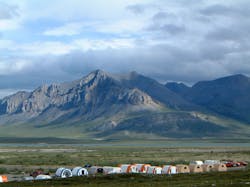An updated assessment estimates 3.6 billion bbl of oil and 8.9 tcf of natural gas are technically recoverable from Alaska’s Central North Slope. The assessment, released Jan. 23 by the US Geological Survey (USGS), is for undiscovered, technically recoverable oil and gas resources in conventional accumulations in the assessment area. The assessment does not include discoveries made by industry between 2013 and 2017.
“Alaska is synonymous with energy, and this assessment just reinforces that,” said USGS Director Jim Reilly. “The State of Alaska and its industry partners have responsibly produced billions of barrels of oil from Prudhoe Bay, and we think there are still billions more in this region that can be produced.”
The assessment consists of six assessment units that range from significant oil resources to significant natural gas resources. Although the USGS assessed this region in 2005, increases in geologic knowledge and understanding of the rocks and resource potential allowed the USGS to focus more specifically on the six assessment units included in this estimate.
In 2005, the USGS assessed some of the same areas as the 2020 assessment. In the 2020 assessment, mean oil is slightly lower than the 3.98 billion bbl assessed in 2005, however about 2.1 billion barrels of oil was assessed in non-Federal areas outside NPR-A, mainly the Central North slope, as part of the 2017 Nanushuk – Torok assessment. In addition, more than one billion barrels of oil have been discovered in the Central North Slope since 2005 by industry.
The assessment area hosts most of the producing oil and gas fields in Arctic Alaska, and the 800-mile-long Trans-Alaska Pipeline spans most of the region.
The supergiant Prudhoe Bay field is within the assessed area, which lies between the National Petroleum Reserve-Alaska to the west, the Brooks Range to the south, and the Arctic National Wildlife Refuge to the east.
The resources estimated in the report are undiscovered, technically recoverable conventional resources. Conventional resources are those that have collected into discrete accumulations that can be produced using traditional production techniques. These are in contrast to continuous resources, which are those spread throughout a rock layer and typically require enhanced recovery techniques such as hydraulic fracturing to produce.
Undiscovered resources are those that have been estimated to exist based on geology and other data, but have not yet been proven to exist by drilling or other means. Technically recoverable resources are those that can be produced using today’s standard industry practices and technology. This is different from reserves, which are those quantities of oil and gas that are currently profitable to produce.


